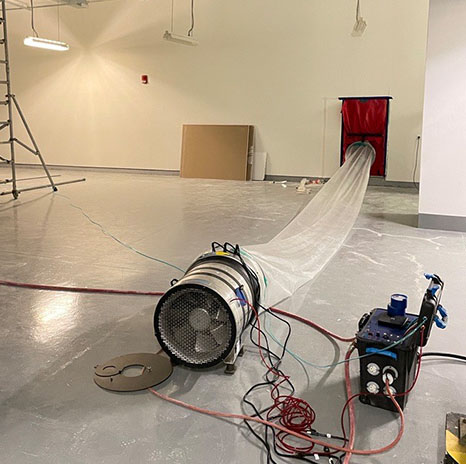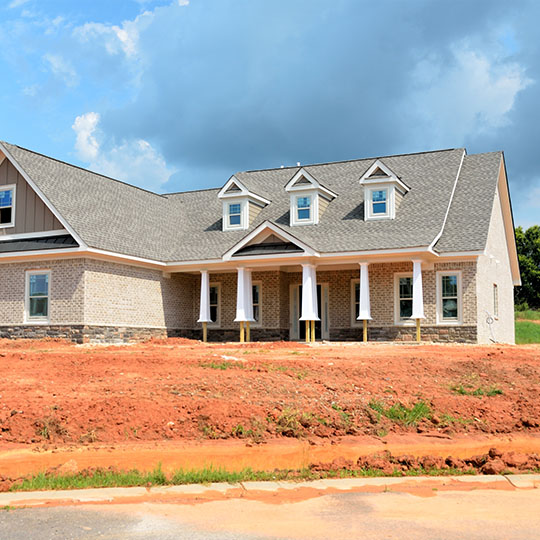Case Study
Commercial: Existing University Building Air Infiltration Issues
Project Overview
Location
Thuwal, Saudi Arabia
Building
King Abdullah University of Science and Technology (KAUST), Al Khawarizmi building
Aerobarrier Installers
Advanced World Trading - AWT
Kaust Engineer
Biju Reghuvaran
Goal
Solve facility’s alarms and mechanical shut down problems caused by condensation from humidity and moisture infiltration issues
Before Aerobarrier
32,904 SF of Wall Surface Area; 757 lineal feet of exterior wall
After Aerobarrier
2.2 ACH50, 3,732 CFM
Results
Achieved airtightness level of 2.2 ACH50 and a reduction in air leakage of 57,839 CFM (about a 94% reduction) and approximately $126,800 in estimated annual operational savings.
Air Sealing Help Kaust Building Run Smoothly While Fighting Elements
Leading Research University in Saudi Arabia Protects Scientific Computing Center with AeroBarrier
The King Abdullah University of Science and Technology (KAUST) in Thuwal, Saudi Arabia offers state-of-the-art facilities, expert academic staff, and a world-class curriculum. These are among the reasons why KAUST is one of the fastest growing research universities in the world with a high-quality research output ranked globally among its peers.
Located on the Red Sea, facilities across its core campus have always been challenged with extreme weather conditions since opening in September 2009. KAUST has tried multiple options to eliminate these issues.
“Our weather puts our facilities in a constant challenge with condensation and moisture infiltration caused by wind driven high humidity, especially due to proximity to the sea.”
Biju Reghuvaran
KAUST’s Civil and Maintenance
Contract Compliance Lead
The AeroBarrier technology is mind-blowing,” Reghuvaran said. “And this project is a remarkable achievement for us. It’s one of the most satisfying projects I’ve worked on in my entire career as an engineer.
Biju Reghuvaran
Civil and Maintenance Contract Compliance Lead
The King Abdullah University of Science and Technology (KAUST)
Keeping the Supercomputing Center Up & Running
The Al Khawarizmi building on the KAUST campus includes the university’s Supercomputing Laboratory, home to the region’s top performing supercomputer. Ranked as one of the world’s fastest, KAUST’s Shaheen II Cray XC40 supercomputer houses computing clusters for scientific and engineering research. Shaheen also services industrial, governmental, and other educational institutions both within the Kingdom and internationally.Since the building opened, infiltration of humidity through the building envelope of its penthouse mechanical room was causing significant problems. Remedies carried out earlier had sealed visible openings in the envelope, but there were several gaps that were either not visible or inaccessible to repair. Sensors and alarms were set off during the high humidity months, shutting down the mechanical equipment and triggering evacuations for the building’s occupants. The Facility Management team at KAUST had spent significant time attempting to manually seal the mechanical room’s envelope, as well as analyzing air sealing methods that ultimately would interfere too much with the building’s operation, take too long, and cost too much. Eventually, they turned to AeroBarrier’s envelope air sealing solution to address the problem, along with Advanced World Trading (AWT) to implement the solution. AWT is an installer of AeroBarrier in Saudi Arabia and specializes in indoor air quality (IAQ) management and infection prevention.
“We knew AeroBarrier’s proven technology could help KAUST solve the air infiltration problems in the Al Khawarizmi building as well as in other buildings on the KAUST campus. Through discussions with the maintenance team at KAUST, we proposed using AeroBarrier to first seal the mechanical room envelope at the Al Khawarizmi building to solve the issues that were disrupting the building’s operations.”
Fadi Shoura
AWT’s Executive Director
Thorough Planning to Ensure Success
A team from KAUST, AWT Services, and AeroBarrier conducted careful planning prior to the start of air sealing to ensure the project’s success. The large area of building envelope surrounding the 457’ x 150’ mechanical room (Fig. 3) needed to be sealed.Considering unique exterior wall construction and campus site constraints, a detailed air sealing plan needed to be developed in advance of being on site to do the actual air sealing work. The team planned to air seal the mechanical room’s exterior walls in segments, with the north, south, and east walls each subdivided differently based on their construction. The west wall is constructed of solid block and didn’t need to be sealed.
Third party exterior thermal imaging assessment and visual inspections showed previous, manual seals of leaks and pipe penetrations were shearing. And a few gaps in the exterior wall less than 1.2cm (0.47”) in size were also found. As a result, the initial blower door tests showed leakage as high as 60 ACH50 in some segments of the building envelope.
Keeping the Supercomputing Center Up & Running
The building envelope construction of the building’s mechanical room, as well as the building’s location on the KAUST campus presented some challenges that were successfully resolved through key advantages provided by AeroBarrier’s air sealing system.- Air sealing without the need to remove the terra cotta panels used as the mechanical room’s exterior finish (Fig. 1).
- Placing AeroBarrier’s sealing stations so that their atomized sealant spray did not get into the mechanical room’s interior, air handling units, and ductwork. Air sealing around several HVAC motor control center (MCC) panels. These clusters of electrical and control pipes required special attention and preparation as part of the air sealing process.
- Conducting the air sealing while ensuring that sealant and debris didn’t fall onto a major pedestrian circulation spine underneath and near the building.
- Working around the university’s high traffic periods and not creating any disruption to the building’s occupants’ work schedules.
- Shorter duration of the rectification works compared to the traditional methods of sealing the envelope.
Applying AeroBarrier Sealant Within the Exterior Wall Cavity
AeroBarrier’s air sealing system pressurizes a space using a blower door and fan, then sprays an atomized sealant mist into that space, causing the sealant to follow the pressurized air escaping through leaks in the building envelope and sealing those leaks. Since avoiding contact between the atomized sealant and the mechanical room equipment was critical, the cavity inside the exterior wall was pressurized and sealant was sprayed directly into the wall cavity to accomplish the air tightness goal for the mechanical room building envelope (Fig. 2).Due to its size, the exterior envelope was sealed in smaller segments. Two different types of sealing station placements were used to seal from the inside of the exterior wall cavity, leveraging the team’s creativity and technical expertise.
Temporary access panels were cut through the interior finish drywall to provide access into the confined space of the wall cavity for further inspection, setup, and preparation work to be carried out, and ultimately to provide access points for the blower door and sealing stations.
For each segment of the envelope, the blower door was then placed into a temporary access panel to pressurize the wall cavity (Fig. 4). Most segments of the envelope were sealed by then deploying sealing stations against the interior face of the exterior wall at these access panels while inserting the spray nozzles inside the cavity and then spraying the sealant mist directly inside (Fig. 5).
In a small number of envelope segments, the wall cavity was deep enough to place the entire sealing station inside the wall so that sealant could then be sprayed into the pressurized cavity (Fig. 6). AeroBarrier’s unique technology and capabilities enabled this customized envelope air sealing approach.
An additional area included a series of control panels that controlled the mechanical equipment, and many conduits that were not possible to get in between and behind to seal the exterior wall. The team successfully sealed this area by constructing temporary walls of framing and plastic film to both pressurize this space and protect the control panels during the sealing process (Fig. 7).
The AeroBarrier system’s Main Control Unit, laptop and software managed the entire process, recording air tightness and leakage reduction in real time.

Results
Verified Air Sealing Results Lead to Operational Savings, Broader Application
Working together, the team achieved airtightness levels below 3 ACH50, a 94% reduction in the mechanical room building envelope air leakage. An estimated $126.8K in annual operational savings are being realized through reductions in both university staff’s time responding to sensor alarms and sealing envelope air leaks, as well as the elimination
of the building evacuations that had caused reductions in productivity for staff working in the building.
These results were achieved with no damage to the HVAC equipment and minimal disruption to building occupants, operations, and the surrounding campus. AeroBarrier successfully sealed the envelope in less than 2 months, a dramatically shorter project than the 10-12 months that would have been needed with other air sealing methods.
Based on this first AeroBarrier air sealing project for the Al Khawarizmi building, KAUST is planning to roll out the use of AeroBarrier on other facilities. In addition to the successful air sealing results, the non-invasive nature of AeroBarrier’s process and support from AWT were a big plus.







